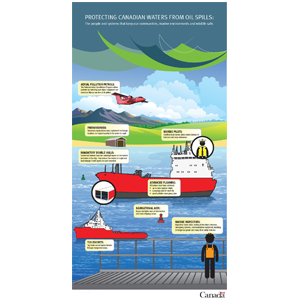Canada has the longest coastline in the world at over 243,000 kilometres. It is vital to protect our waters and communities from ship-source pollution because:
- Each year, tankers carry about 80 million tonnes of oil from Canada's coasts.
- Each day, about 180 large commercial vessels travel within 200 miles of our shores.
Read more information on this page about tanker safety.
For a quick overview, read the brochure World-Class Tanker Safety (PDF, 215 KB) or view:
- Protecting Canadian waters from oil spills - infographic
- Tanker Safety by the Numbers – infographic
On this page:
- Oil spill statistics in Canada
- Tanker statistics on the East Coast
- Tanker statistics on the West Coast
- Tanker statistics on the Arctic Coast
- Tanker statistics in the Saint Lawrence Seaway and Great Lakes
Oil spill statistics in Canada
The largest oil spill in Canada occurred off the East Coast in 1970. The tanker M/T Arrow spilled over 10,000 tonnes of oil off Nova Scotia. This is about one quarter the amount spilled in US waters by the Exxon Valdez in 1989.
The West Coast's largest spill was 240 tonnes, caused by the sinking of the ferry M/V The Queen of the North in 2006. In 1988, the Nestucca oil barge spilled 87 tonnes of oil off the west coast of Vancouver Island.
In 2015, the M/V Marathassa was reported to have spilled fuel oil in Vancouver's English Bay. Read the independent review for more information.
Tanker statistics on the East Coast
The East Coast has about 4,000 inbound trips by tankers each year. Tankers account for about one fifth of the 20,000 inbound vessel trips on the East Coast.
Over 82 million tonnes of various petroleum and fuel products are moved in and out of 23 Atlantic Canada ports. Almost all the movement of crude oil and petroleum products in Atlantic Canada is through the following ports:
- Come by Chance, Newfoundland and Labrador
- Port Hawkesbury, Nova Scotia
- Saint John, New Brunswick
In Quebec, 25 million tonnes of crude oil and various petroleum products are moved in and out of 39 ports where cargo is loaded or unloaded.
Eighty-nine per cent of the shipments of crude oil and various petroleum products are through Quebec City and Montreal.
Tanker statistics on the West Coast
Oil tankers have been moving along Canada's West Coast since the 1930s.
In 2015, there were about 197,513 departures and arrivals of vessels at West Coast ports. Tankers accounted for about 1487 of them, or 0.75 per cent.
Oil is moved mostly via the following ports:
- Vancouver
- Prince Rupert
- Kitimat
Much of the oil shipped out of Vancouver is transported to and from communities on the B.C. coast. Oil is carried by barges, container ships, ferries, and other types of commercial and private vessels.
Tanker statistics on the Arctic Coast
Tankers travel the Arctic mostly to resupply communities and service natural resource projects.
However, an increase is expected in the number of tankers transiting Arctic waters in the next few decades.
Climate change is affecting Arctic transportation. For example, melting sea-ice is extending the shipping season, increasing marine traffic in the North.
In 2015, eleven regulated vessels shipped product within the Arctic. Most of these were Canadian vessels.
Vessels must follow specific rules for Arctic shipping, which are designed to ensure safe operations in northern weather conditions.
Tanker statistics in the Saint Lawrence Seaway and Great Lakes
Over 4.1 million tonnes of oil products are moved from 29 marine facilities in and out of ports in the Great Lakes – St. Lawrence Seaway. Of this:
- over 1.8 million tonnes are shipped between Canada and the United States
- over 2.3 million tonnes are imported/exported in and out of the Great Lakes – St. Lawrence Seaway system.
Tankers carrying oil products account for 7 percent of all shipments completed in the Great Lakes – St. Lawrence Seaway. Heavy crude oil is not currently transported on the Great Lakes – St. Lawrence Seaway.


